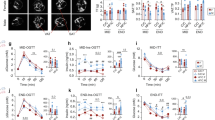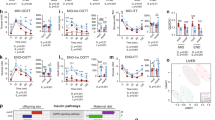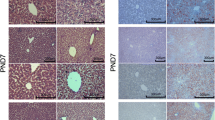Abstract
Maternal high-fat diet (HFD) consumption during pregnancy and lactation affects metabolic outcomes and lipid metabolism of offspring in later life in a gender-specific manner. However, it is not known whether maternal HFD alters bile acid metabolism in adult mice offspring. The purpose of this study was to elucidate the relationship between maternal HFD-induced metabolic diseases and bile acid metabolism in male and female adult mice offspring. Female mice were fed either standard chow (C) or HFD (H) for 10 weeks pre-pregnancy until lactation. After weaning, offspring were fed a chow diet until 11 weeks of age, then challenged with either C or H diet for 4 weeks, and divided into eight groups in accordance with mother’s and offspring’s diets: male(M) CC, MHC, MCH, MHH, female(F) CC, FHC, FCH, and FHH. MHH showed greater weight gain compared to FHH. Liver weight was higher in MHH than in FHH. Serum total cholesterol levels were higher in MHH than in MHC, and tended to be higher in MHH than in FHH. Serum glucose levels were higher in MHH than in MHC. Hepatic triglyceride levels were higher in MHH than in MHC. Hepatic mRNA expression of bile acid uptake transporters Oatp1a1 and Oatp1b2 was increased in MHH, compared to MCH. Hepatic mRNA expression of HMGCoAR, Cyp7a1, Sult2a1, and Oatp1a4 was increased in FHH, compared to FCH. In conclusion, maternal HFD consumption may promote bile acid synthesis, sulfation and excretion in female offspring fed a HFD, which may confer resistance to HFD-induced metabolic phenotypes.




Similar content being viewed by others
References
Bahia L, Aguiar LG, Villela N, Bottino D, Godoy-Matos AF, Geloneze B, Tambascia M and Bouskela E 2006 Relationship between adipokines, inflammation, and vascular reactivity in lean controls and obese subjects with metabolic syndrome. Clinics 61 433–440
Benatti RO, Melo AM, Borges FO, Ignacio-Souza LM, Simino LA, Milanski M, Velloso LA, Torsoni MA and Torsoni AS 2014 Maternal high-fat diet consumption modulates hepatic lipid metabolism and microRNA-122 (miR-122) and microRNA-370 (miR-370) expression in offspring. Br. J. Nutr. 111 2112–2122
Bohan A, Chen WS, Denson LA, Held MA and Boyer JL 2003 Tumor necrosis factor alpha-dependent up-regulation of Lrh-1 and Mrp3(Abcc3) reduces liver injury in obstructive cholestasis. J. Biol. Chem. 278 36688–36698
Burgueño AL, Cabrerizo R, Gonzales Mansilla N, Sookoian S and Pirola CJ 2013 Maternal high-fat intake during pregnancy programs metabolic-syndrome-related phenotypes through liver mitochondrial DNA copy number and transcriptional activity of liver PPARGC1A. J. Nutr. Biochem. 24 6–13
Burke KT, Colvin PL, Myatt L, Graf GA, Schroeder F and Woollett LA 2009 Transport of maternal cholesterol to the fetus is affected by maternal plasma cholesterol concentrations in the golden Syrian hamster. J. Lipid. Res. 50 1146–1155
Cnop M, Havel PJ, Utzschneider KM, Carr DB, Sinha MK, Boyko EJ, Retzlaff BM, Knopp RH, Brunzell JD and Kahn SE 2003 Relationship of adiponectin to body fat distribution, insulin sensitivity and plasma lipoproteins: evidence for independent roles of age and sex. Diabetologia 46 459–469
Csanaky IL, Lu H, Zhang Y, Ogura K, Choudhuri S and Klaassen CD 2011 Organic anion-transporting polypeptide 1b2 (Oatp1b2) is important for the hepatic uptake of unconjugated bile acids: Studies in Oatp1b2-null mice. Hepatology 53 272–281
Dahlhoff M, Pfister S, Blutke A, Rozman J, Klingenspor M, Deutsch MJ, Rathkolb B, Fink B, Gimpfl M, Hrabě de Angelis M, Roscher AA, Wolf E and Ensenauer R 2014 Peri-conceptional obesogenic exposure induces sex-specific programming of disease susceptibilities in adult mouse offspring. Biochim. Biophys. Acta. 1842 304–317
Desai M, Jellyman JK, Han G, Beall M, Lane RH and Ross MG 2014 Maternal obesity and high-fat diet program offspring metabolic syndrome. Am. J. Obstet. Gynecol. 211 237.e1–237.e13
Elahi MM, Cagampang FR, Mukhtar D, Anthony FW, Ohri SK and Hanson MA 2009 Long-term maternal high-fat feeding from weaning through pregnancy and lactation predisposes offspring to hypertension, raised plasma lipids and fatty liver in mice. Br. J. Nutr. 102 514–519
Finucane MM, Stevens GA, Cowan MJ, Danaei G, Lin JK, Paciorek CJ, Singh GM, Gutierrez HR, Lu Y, Bahalim AN, Farzadfar F, Riley LM and Ezzati M 2011 National, regional, and global trends in body-mass index since 1980: systematic analysis of health examination surveys and epidemiological studies with 960 country-years and 9·1 million participants. Lancet 377 557–567
Folch J, Lee M and Stanley GHS 1957 A simple method for the isolation and purification of total lipids from animal tissues. J. Biol. Chem. 226 497–509
Fu ZD, Csanaky IL and Klaassen CD 2012 Effects of aging on mRNA profiles for drug-metabolizing enzymes and transporters in livers of male and female mice. Drug. Metab. Dispos. 40 1216–1225
González Calvo G, Hernández Sánchez S, Pozo Rosado P and García López D 2011 Positive effects of physical exercise on reducing the relationship between subcutaneous abdominal fat and morbility risk. Nutr. Hosp. 26 685–691
Goodwin B, Jones SA, Price RR, Watson MA, McKee DD, Moore LB, Galardi C, Wilson JG, Lewis MC, Roth ME, Maloney PR, Willson TM and Kliewer SA 2000 A regulatory cascade of the nuclear receptors FXR, SHP-1, and LRH-1 represses bile acid biosynthesis. Mol. Cell. 6 517–526
Hirokane H, Nakahara M, Tachibana S, Shimizu M and Sato R 2004 Bile acid reduces the secretion of very low density lipoprotein by repressing microsomal triglyceride transfer protein gene expression mediated by hepatocyte nuclear factor-4. J. Biol. Chem. 279 45685–45692
Howie GJ, Sloboda DM and Vickers MH 2012 Maternal undernutrition during critical windows of development results in differential and sex-specific effects on postnatal adiposity and related metabolic profiles in adult rat offspring. Br. J. Nutr. 108 298–307
Ikemoto S, Takahashi M, Tsunoda N, Maruyama K, Itakura H, Kawanaka K, Tabata I, Higuchi M, Tange T, Yamamoto TT and Ezaki O 1997 Cholate inhibits high-fat diet-induced hyperglycemia and obesity with acyl-CoA synthetase mRNA decrease. Am. J. Physiol. 273 E37–45
Ito J, Nakagawa K, Kato S, Miyazawa T, Kimura F and Miyazawa T 2016 The combination of maternal and offspring high-fat diets causes marked oxidative stress and development of metabolic syndrome in mouse offspring. Life. Sci. 151 70–75
Kamisako T, Tanaka Y, Ikeda T, Yamamoto K and Ogawa H 2012 Dietary fish oil regulates gene expression of cholesterol and bile acid transporters in mice. Hepatol. Res. 42 321–326
Kamisako T, Tanaka Y, Kishino Y, Ikeda T, Yamamoto K, Masuda S and Ogawa H 2014 Role of Nrf2 in the alteration of cholesterol and bile acid metabolism-related gene expression by dietary cholesterol in high fat-fed mice. J. Clin. Biochem. Nutr. 54 90–94
Kars M, Yang L, Gregor MF, Mohammed BS, Pietka TA, Finck BN, Patterson BW, Horton JD, Mittendorfer B, Hotamisligil GS and Klein S 2010 Tauroursodeoxycholic Acid may improve liver and muscle but not adipose tissue insulin sensitivity in obese men and women. Diabetes 59 1899–1905
Kim J, Kim J and Kwon YH 2016 Effects of disturbed liver growth and oxidative stress of high-fat diet-fed dams on cholesterolmetabolism in offspring mice. Nutr. Res. Pract. 10 386–392
Li L, Meier PJ and Ballatori N 2000 Oatp2 mediates bidirectional organic solute transport: a role for intracellular glutathione. Mol. Pharmacol. 58 335–340
Li T, Owsley E, Matozel M, Hsu P, Novak CM and Chiang JY 2010 Transgenic expression of cholesterol 7alpha-hydroxylase in the liver prevents high-fat diet-induced obesity and insulin resistance in mice. Hepatology 52 678–690
Masuyama H and Hiramatsu Y 2012 Effects of a high-fat diet exposure in utero on the metabolic syndrome-like phenomenon in mouse offspring through epigenetic changes in adipocytokine gene expression. Endocrinology 153 2823–2830
Mazuy C, Helleboid A, Staels B and Lefebvre P 2015 Nuclear bile acid signaling through the farnesoid X receptor. Cell Mol. Life Sci. 72 1631–1650
More VR and Slitt AL 2011 Alteration of hepatic but not renal transporter expression in diet-induced obese mice. Drug. Metab. Dispos. 39 992–999
Nie B, Park HM, Kazantzis M, Lin M, Henkin A, Ng S, Song S, Chen Y, Tran H, Lai R, Her C, Maher JJ, Forman BM and Stahl A 2012 Specific bile acids inhibit hepatic fatty acid uptake in mice. Hepatology 56 1300–1310
Ornellas F, Mello VS, Mandarim-de-Lacerda CA and Aguila MB 2013 Sexual dimorphism in fat distribution and metabolic profile in mice offspring from diet-induced obese mothers. Life Sci. 93 454–463
Pettersson US, Waldén TB, Carlsson PO, Jansson L and Phillipson M 2012 Female mice are protected against high-fat diet induced metabolic syndrome and increase the regulatory T cell population in adipose tissue. PLoS One 7 e46057
Regitz-Zagrosek V, Lehmkuhl E and Weickert MO 2006 Gender differences in the metabolic syndrome and their role for cardiovascular disease. Clin. Res. Cardiol. 95 136–147
Riant E, Waget A, Cogo H, Arnal JF, Burcelin R and Gourdy P 2009 Estrogens protect against high-fat diet-induced insulin resistance and glucose intolerance in mice. Endocrinology 150 2109–2117
Tanaka Y, Aleksunes LM, Yeager RL, Gyamfi MA, Esterly N, Guo GL and Klaassen CD 2008 NF-E2-related factor 2 inhibits lipid accumulation and oxidative stress in mice fed a high-fat diet. J. Pharmacol. Exp. Ther. 325 655–664
Tanaka Y, Ikeda T, Yamamoto K, Ogawa H and Kamisako T 2012 Dysregulated expression of fatty acid oxidation enzymes and iron-regulatory genes in livers of Nrf2-null mice. J. Gastroenterol. Hepatol. 27 1711–1717
Tarling EJ, Ryan KJ, Austin R, Kugler SJ, Salter AM and Langley-Evans SC 2016 Maternal high-fat feeding in pregnancy programs atherosclerotic lesion size in the ApoE*3 Leiden mouse. J. Dev. Orig. Health. Dis. 2 1–8
Trauner M, Claudel T, Fickert P, Moustafa T and Wagner M 2010 Bile acids as regulators of hepatic lipid and glucose metabolism. Dig. Dis. 28 220–224
Tsekouras YE, Magkos F, Kavouras SA, Panagiotakos DB and Sidossis LS 2008 Estimated liver weight is directly related to hepatic very low-density lipoprotein-triglyceride secretion rate in men. Eur. J. Clin. Invest. 38 656–662
Watanabe M, Houten SM, Mataki C, Christoffolete MA, Kim BW, Sato H, Messaddeq N, Harney JW, Ezaki O, Kodama T, Schoonjans K, Bianco AC and Auwerx J 2006 Bile acids induce energy expenditure by promoting intracellular thyroid hormone activation. Nature 439 484–489
Watanabe M, Houten SM, Wang L, Moschetta A, Mangelsdorf DJ, Heyman RA, Moore DD and Auwerx J 2004 Bile acids lower triglyceride levels via a pathway involving FXR, SHP, and SREBP-1c. J. Clin. Invest. 113 1408–1418
Yokomizo H, Inoguchi T, Sonoda N, Sakaki Y, Maeda Y, Inoue T, Hirata E, Takei R, Ikeda N, Fujii M, Fukuda K, Sasaki H and Takayanagi R 2014 Maternal high-fat diet induces insulin resistance and deterioration of pancreatic β-cell function in adult offspring with sex differences in mice. Am. J. Physiol. Endocrinol. Metab. 306 E1163–1175
Yoshida S and Wada Y 2005 Transfer of maternal cholesterol to embryo and fetus in pregnant mice. J. Lipid. Res. 46 2168–2174
Zhang Y, Csanaky IL, Selwyn FP, Lehman-McKeeman LD and Klaassen CD 2013 Organic anion-transporting polypeptide 1a4 (Oatp1a4) is important for secondary bile acid metabolism. Biochem. Pharmacol. 86 437–445
Zhang Y, Limaye PB, Lehman-McKeeman LD and Klaassen CD 2012 Dysfunction of organic anion transporting polypeptide 1a1 alters intestinal bacteria and bile acid metabolism in mice. PLoS One 7 e34522
Zheng J, Xiao X, Zhang Q, Yu M, Xu J and Wang Z 2014 Maternal high-fat diet modulates hepatic glucose, lipid homeostasis and gene expression in the PPAR pathway in the early life of offspring. Int. J. Mol. Sci. 15 14967–14983
Acknowledgements
The authors would like to thank Yoko Saito and Mariko Shibayama for technical assistance. This work was supported by a Grant-in-Aid for Scientific Research (C) 15K00860.
Author information
Authors and Affiliations
Corresponding author
Additional information
Communicated by ULLAS KOLTHUR-SEETHARAM.
Corresponding editor: Ullas Kolthur-Seetharam
Electronic supplementary material
Below is the link to the electronic supplementary material.
Rights and permissions
About this article
Cite this article
Tanaka, Y., Ikeda, T., Yamamoto, K. et al. Gender-divergent expression of lipid and bile acid metabolism-related genes in adult mice offspring of dams fed a high-fat diet. J Biosci 43, 329–337 (2018). https://doi.org/10.1007/s12038-018-9750-9
Received:
Accepted:
Published:
Issue Date:
DOI: https://doi.org/10.1007/s12038-018-9750-9




